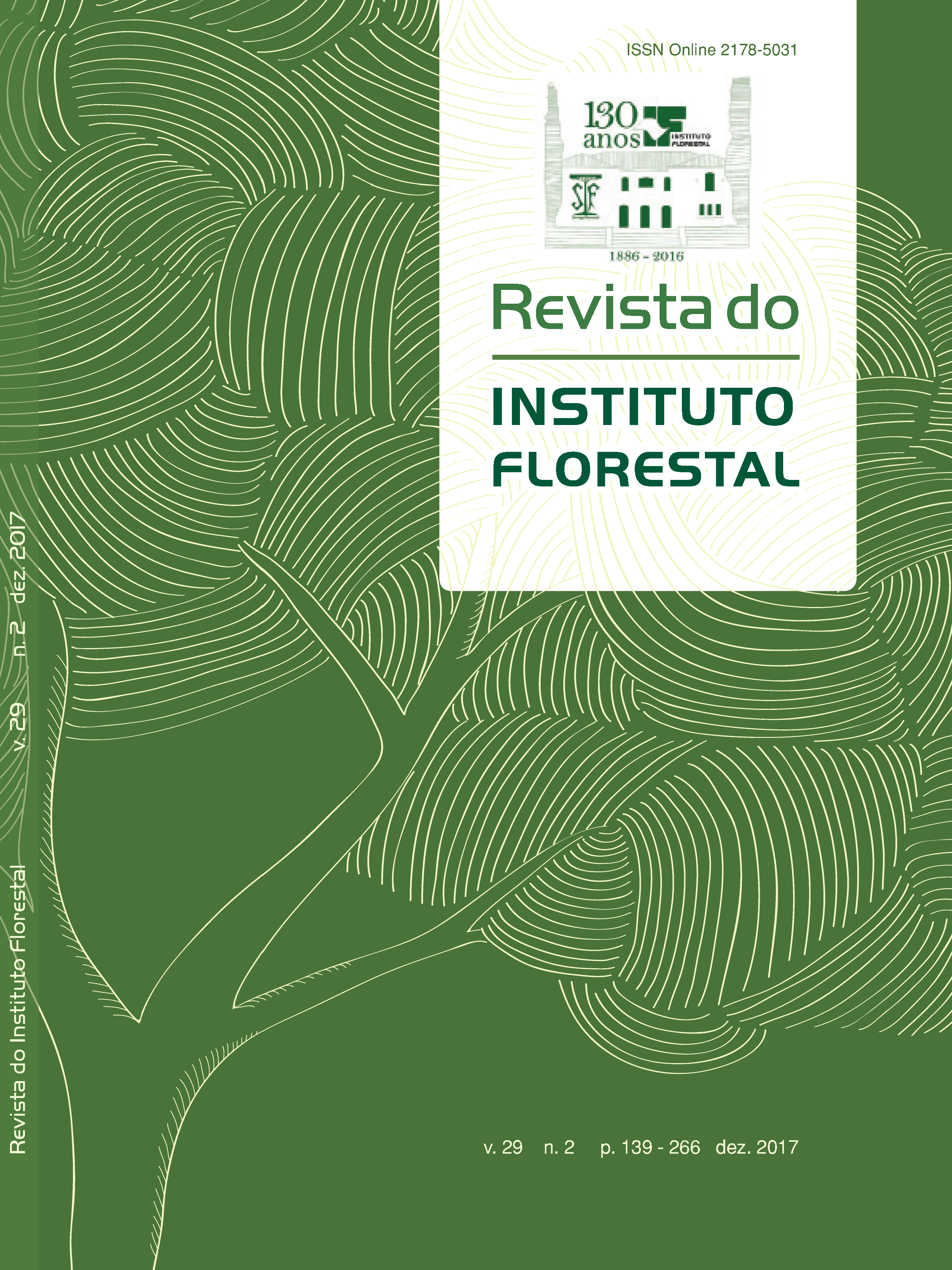PHYSIOLOGICAL ASPECTS OF EUCALYPTUS IN COEXISTENCE WITH THREE WEED SPECIES
DOI:
https://doi.org/10.24278/2178-5031.201729201Keywords:
Eucalyptus spp., Commelinea bengalensis, Ipomoeia grandifolia, Urochloa brizantha, competitive potentialAbstract
The weeds Commelinea bengalensis (trapoeraba), Ipomoea grandifolia (corda-de-viola) and Urochloa brizantha (braquiária) are commonly found in competition with eucalyptus cultivation, and unwieldy for the sole use of herbicides. The aggressiveness evaluation of these species by physiological variables measured in culture may be useful in the establishment of alternative control strategies to herbicide application. Thus, this study aimed to evaluate the effect of coexistence period of trapoeraba, corda-de-viola and braquiária on physiological characteristics of eucalyptus plants.The experimental design was a randomized block design – RBD with four replications, in a factorial 3 x 3, being the factor represented by three species assessed: C. bengalensis, I. grandifolia and U. brizantha and factor B representing the three periods of coexistence culture with weeds: control (cultured without weeds), 60 days living and 105 two eucalyptus coexistence with weeds. The three species evaluated promoted negative effects on eucalyptus physiological characteristics promoting reduction in photosynthetic rate and water use efficiency, and percentage increase in the concentration of internal carbon and transpiration rate. The three evaluated species affected in a similar way the physiological characteristics of culture.
Downloads
References
BAPTISTA, J.M.; ALMEIDA, M.D.; VIEIRA, P. Programa nacional para o uso eficiente da água. Instituto Superior de Agronomia, v. 1, n. 1, 2012. Disponível em: <https://www.apambiente.pt/_zdata/CONSULTA_PUBLICA/2012/PNUEA/Implementacao-PNUEA_2012-2020_JUNHO.pdf>. Acesso em: 17 fev. 2017.
CONCENÇO, G. et al. Uso da água em biótipos de azevém (Lolium multiflorum) em condição de competição. Planta Daninha, v. 25, n. 3, p. 449-455, 2007.
______. et al. Uso da água por plantas de arroz em competição com biótipos de Echinochloa crusgalli resistente e suscetível ao herbicida quinclorac. Planta Daninha, v. 27, n. 2, p. 249-256, 2009.
FAUSTINO, L.A. Convivência de eucalipto com Commelina benghalensis. 2015. 40 f. Dissertação (Mestrado em Fitotecnia) – Universidade Federal de Viçosa, Viçosa, MG.FERREIRA, G.L. et al. Eucalypt growth submitted to management of Urochloa spp. Planta Daninha, v. 34, n. 1, p. 99-107, 2016.
FLOSS, E.L. Fisiologia das plantas cultivadas. Passo Fundo: Universidade de Passo Fundo, 2011. v. 4, 734 p.
GALON, L. et al. Estimativa das perdas de produtividade de grãos em cultivares de arroz (Oryza sativa) pela interferência do capim-arroz (Echinochloa spp.). Planta Daninha, v. 25, n. 3, p. 697-707, 2007.
JONES, H.G. Stomatal control of photosynthesis and transpiration. Journal of Experimental Botany, v. 49, p. 387-398, 1998. Special Issue.
MACHADO, A.F.L. et al. Eficiência fotossintética e uso da água em plantas de eucalipto pulverizadas com glyphosate. Planta Daninha, v. 28, n. 2, p. 319-327, 2010.
MATOS, C.C. et al. Características fisiológicas do cafeeiro em competição com plantas daninhas. Bioscience Journal, v. 29, n. 5, p. 1111-1119, 2013.
MELO, P.T.B.S. et al. Comportamento de populações de arroz irrigado em função das proporções de plantas originadas de sementes de alta e baixa qualidade fisiológica. Revista Brasileira de Agrociência, v. 12, n. 1, p. 37-43, 2006.
MESSINGER, S.M. et al. Evidence for involvement of photosynthetic processes in the stomatal response to CO2. Plant Physiology, v. 140, n.2, p. 771-778, 2006.
PEREIRA-NETTO, A.B. Crescimento e desenvolvimento. In: WACHOWICZ, C.M.; CARVALHO, R.I.N. (Ed.). Fisiologia vegetal – produção e pós-colheita. Curitiba: Champagnat, 2002. p. 17-42.
RADOSEVICH, S.; HOLT, J.; GHERSA, C. Physiological aspects of competition. In: STEVEN, R. et al. (Ed.). Weed ecology implicatios for managements. New York: John Willey and Sons, 1996. p. 217-301.
RIGOLI, R.P. et al. Habilidade competitiva relativa do trigo (Triticum aestivum) em convivência com azevém (Lolium multiflorum) ou nabo (Raphanus raphanistrum). Planta Daninha, v. 26, n. 1, p. 93-100, 2008.
SHARKEY, T.D.; RASCHKE, K. Effect of light quality on stomatal opening in leaves of Xanthium strumarium L. Plant Physiology, v. 68, n. 5, p. 1170-1174, 1981.
SILVA, A.A. et al. Herbicidas: classificação e mecanismo de ação. In: SILVA, A.A.; SILVA, J.F. (Ed.). Tópicos em manejo de plantas daninhas. Viçosa: Universidade Federal de Viçosa, 2007. p. 83-148.
SILVA, W. et al. Taxa fotossintética líquida de Eucalyptus citriodora Hook e E. grandis W. Hill em resposta à diferentes níveis de água no solo e associação com Brachiaria brizantha Stapf. Acta Scientiarum, v. 23, n. 5, p. 1205-1209, 2001.
TAIZ, L.; ZEIGER, E. Fisiologia vegetal. Porto Alegre: Artmed, 2013. v. 5, 954 p.
TYREE, M.T.; SPERRY, J.S. Do woody plants operate near the point of catastrophic xylem dysfunction caused by dynamic water stress? Answers from a model. Plant Physiology, v. 88, n. 3, p. 574-580, 1988.
VIDAL, R.A. et al. Nível de dano econômico de Brachiaria plantaginea na cultura de milho irrigado. Planta Daninha, v. 22, n. 1,p. 63-69, 2
WINKLER, L.M.; VIDAL, R.A.; BARBOSA NETO, J.F. Aspectos genéticos envolvidos na resistência de plantas daninhas aos herbicidas. Plantio Direto, v. 70, n. 1, p. 21-24, 2002.
















